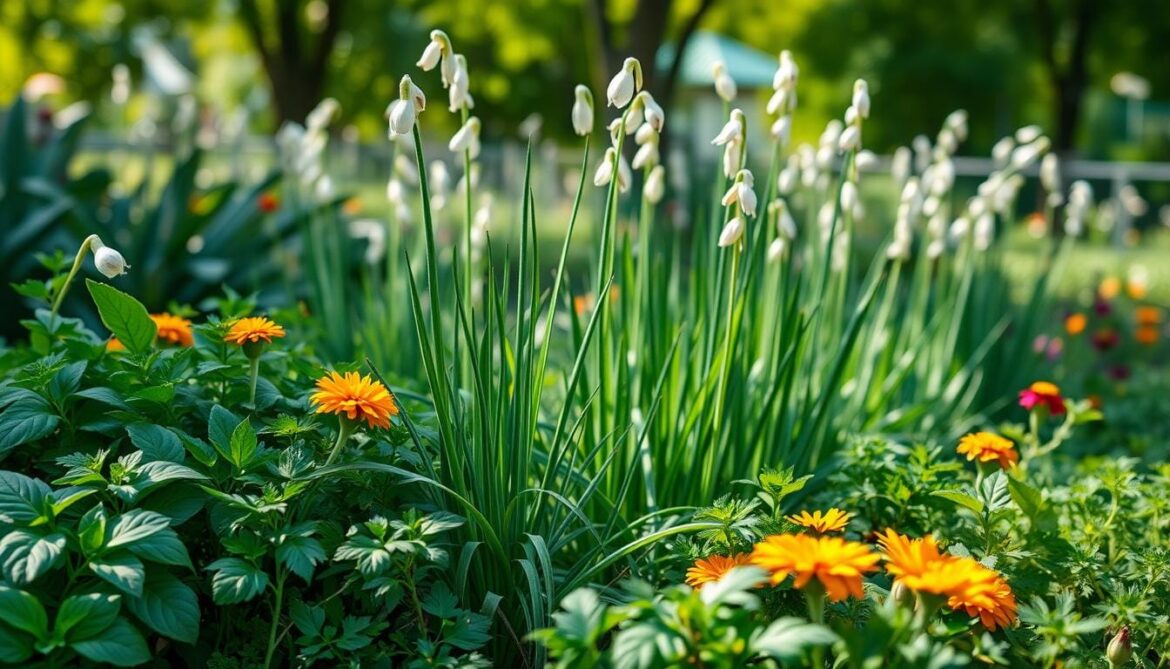There’s nothing more rewarding than pulling out a big, tasty garlic bulb after months of work. But, many gardeners struggle with small cloves, pests, or poor soil. What if you could grow bigger, tastier garlic without using chemicals or guessing?
Companion planting is the answer. It’s a way to pair garlic with certain plants to help it grow better. This guide will show you how garlic companion plants can make your garden better. You’ll learn how companion planting with garlic keeps pests away, makes the soil better, and increases your harvest. It’s a way to garden that works with nature, not against it.
Key Takeaways
- Pairing garlic with the right plants improves growth and flavor.
- Natural pest control reduces reliance on harmful chemicals.
- Companion plants enhance soil health for stronger garlic crops.
- Strategic planting boosts harvest size and quality.
- This guide offers actionable steps for beginners and experts alike.
What are Companion Plants?
Companion planting with garlic is an old gardening trick. It pairs plants to help each other grow better. This method, like the “three sisters” of Native American farming, makes plants work together. A garlic companion planting guide shows how plants help each other.
Definition and Purpose
Companion plants are grown together for mutual benefits. For garlic, this means picking plants that keep pests away or improve the soil. Key purposes include:
- Pest reduction through natural repellents
- Soil nutrient sharing
- Space optimization in small gardens
Benefits of Companion Planting
Using a garlic companion planting guide brings many benefits like:
- Pest control: Marigolds repel harmful insects near garlic crops
- Soil enrichment: Legumes add nitrogen to soil, boosting garlic growth
- Higher yields: Proper pairings increase bulb size and plant vigor
Modern science backs up what farmers have always known. Plants talk to each other through roots and smells. This teamwork cuts down on chemical pesticides and boosts harvest quality.
Best Companion Plants for Garlic
Choosing the right best companion plants for garlic boosts garden productivity. These partnerships leverage natural pest control and shared growing needs. Discover how to pair garlic with vegetables and herbs for thriving crops.
Top Vegetables to Plant Alongside Garlic
Vegetables like tomatoes, peppers, and carrots thrive when planted near garlic. Here’s why:
- Tomatoes: Garlic repels aphids and spider mites. Better Homes and Gardens notes this duo deters common pests.
- Carrots: Garlic’s scent masks carrot roots from flies, improving yields.
- Beets: These root vegetables share soil preferences, thriving in well-drained beds.
Herbs that Pair Well with Garlic
Herbs like chamomile and dill enhance soil health and deter pests. Consider these ideal garlic companions:
- Chamomile: Releases nutrients that improve garlic flavor and reduce disease risk.
- Dill: Attracts beneficial wasps that prey on tomato hornworms and other pests.
- Parsley: Fixes soil nitrogen, benefiting neighboring plants.
Pairing garlic with these plants creates a balanced ecosystem. Avoid legumes and asparagus, which compete for nutrients. Focus on mutual benefits for pest control and growth.
The Benefits of Growing Garlic with Other Plants
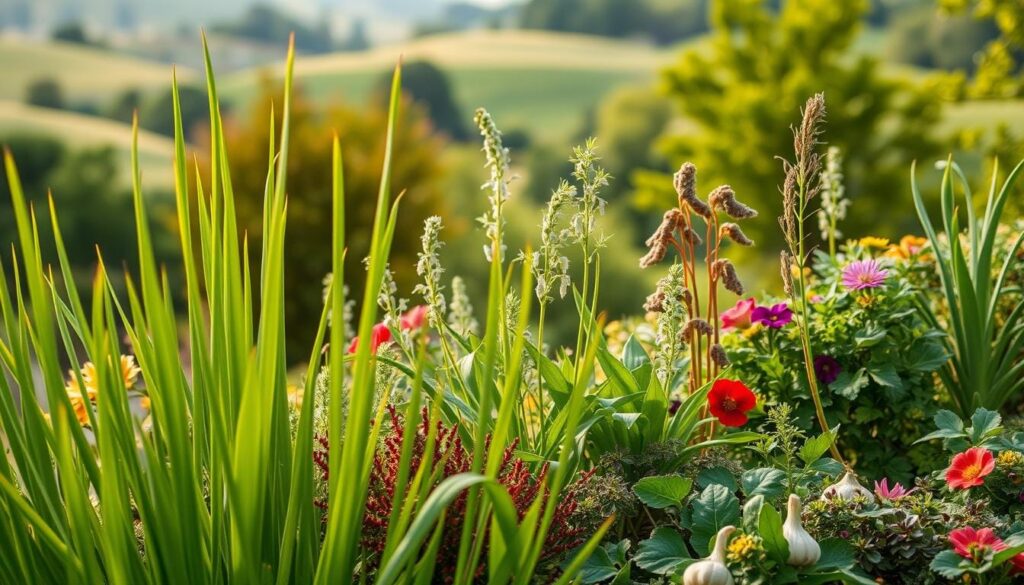
Garlic planting companions do more than share space. They create thriving ecosystems. By growing garlic with other plants, gardeners get natural pest control, nutrient-rich soil, and tastier garlic.
These tips help increase garlic yield and cut down on chemical use. It’s a win-win for gardeners and their plants.
Pest Control
Garlic’s sulfur compounds keep aphids, Japanese beetles, and carrot rust flies away. It also helps roses and tomatoes by breaking pest cycles. For instance, planting garlic with carrots hides their scent from pests.
- Aphids avoid sulfur-scented garlic beds
- Marigolds near garlic roots deter nematodes
- Rose beds gain protection from black spot when garlic is nearby
Improved Soil Health
Garlic planting tips often include nitrogen-fixing legumes like clover. These plants improve soil structure and feed garlic bulbs. Marigolds’ deep roots help aerate clay soils, while radishes prevent disease buildup.
Rotate crops yearly to avoid nutrient loss. This keeps the soil healthy for future plants.
Enhanced Flavor Profiles
“Garlic grown near basil develops a sweeter, less pungent taste,” says the National Gardening Association. Herbs like thyme and rosemary make garlic’s aroma stronger. On the other hand, beans near garlic prevent it from becoming bitter.
Pairing garlic with brassicas like kale boosts their defense against caterpillars. These relationships make both plants more resilient and flavorful.
Plants to Avoid Near Garlic
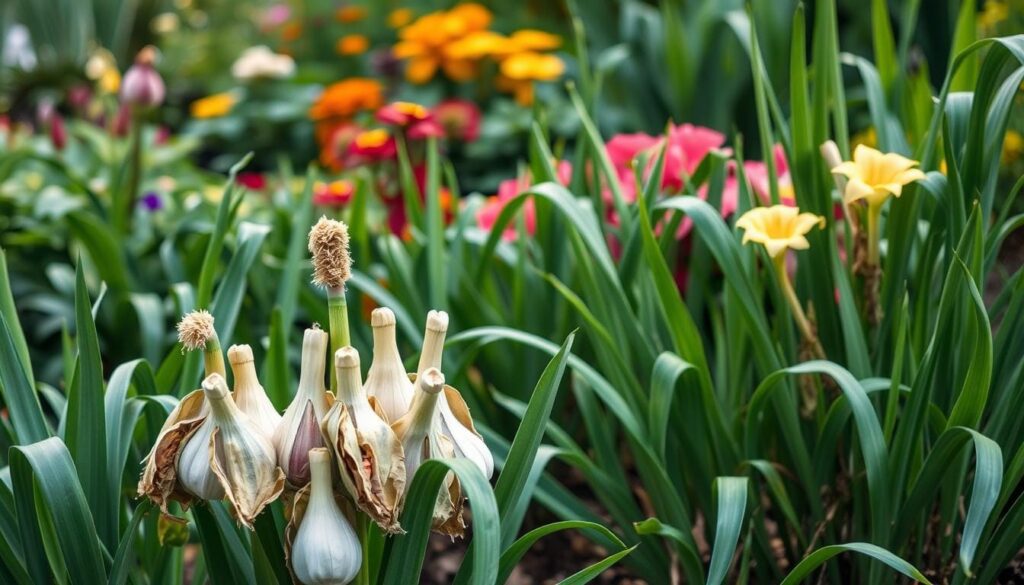
Knowing which plants to avoid is key for garlic garden companions. Some veggies can harm garlic’s growth. Use a garlic companion planting chart to steer clear of these issues.
Incompatible Vegetables to Keep Away
- Legumes like beans and peas compete fiercely for nutrients
- Asparagus struggles in garlic’s soil amendments
- Brassicas (cabbage, broccoli) attract shared pests
- Onions and shallots overcrowd root zones
Why Some Plants Don’t Thrive with Garlic
Legumes fix nitrogen but take away phosphorus garlic needs. Asparagus prefers acidic soils, unlike garlic. Brassicas share downy mildew risks. Overlapping roots cause stunted growth.
“Avoid planting brassicas near garlic to prevent disease spread” – USDA Agricultural Handbook
Check a garlic companion planting chart for visual guides. These plants can lower yields due to chemicals or pests. Always consider spacing and soil testing in your garden planning.
How to Plant Garlic with Companion Plants
Learning the garlic companion planting guide is key to a thriving garden. Follow these garlic companion planting tips to create layouts that meet growth needs and use space well.
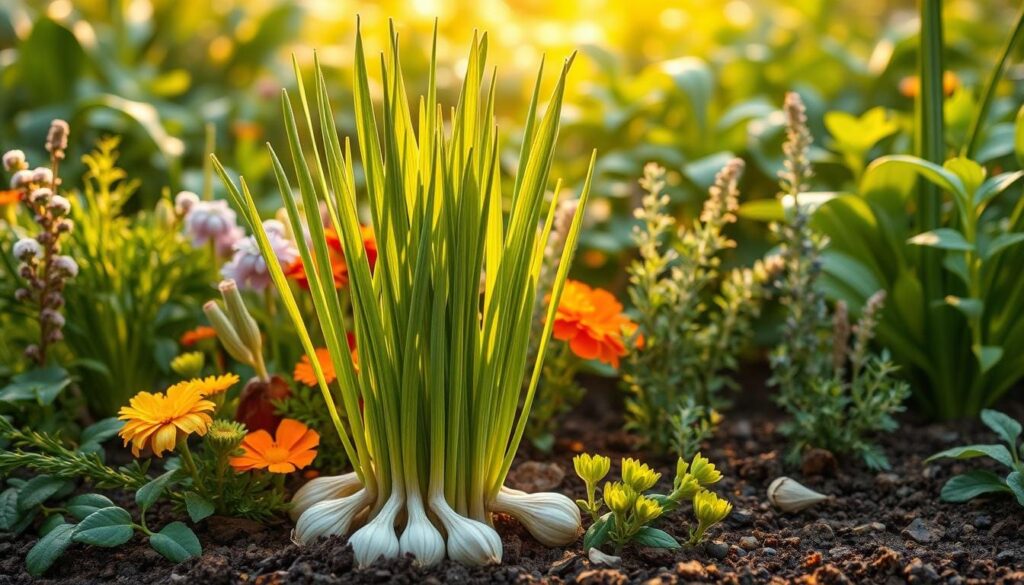
Ideal Spacing and Arrangement
Plant garlic bulbs 6–8 inches apart in rows. Make sure to leave 12–18 inches between rows for companion plants to grow. Place low-growing herbs like basil or thyme between garlic rows. Taller plants, such as sunflowers, should go north of garlic to prevent shading.
- Interplant marigolds every 12 inches to deter pests.
- Use raised beds for moisture-sensitive companions like sage.
- Alternate garlic cloves with carrots or beets in the same row.
Timing for Planting
Plant garlic in the fall, 4–6 weeks before the first frost. Wait until spring to add companions. Sow fast-growing greens like spinach between garlic rows in early spring. Plant summer crops like peppers after garlic scapes are cut in late spring.
A sample schedule: Plant garlic in October, radishes in March, and bush beans in May. Adjust timing based on local frost dates and companion maturity cycles.
“Timing is key—companion crops mustn’t overshadow garlic’s growth cycle.”
Garlic’s Nutritional Requirements
Healthy garlic grows best when its soil and water match those of its ideal garlic companions. Good nutrition helps both garlic and its neighbors grow strong. Here’s how to share resources well.
Soil Needs for Companion Success
Garlic needs well-drained, loamy soil with lots of organic matter. A pH of 6.0–7.0 helps it absorb nutrients. For garlic planting companions like carrots or spinach, make sure the soil is right for both.
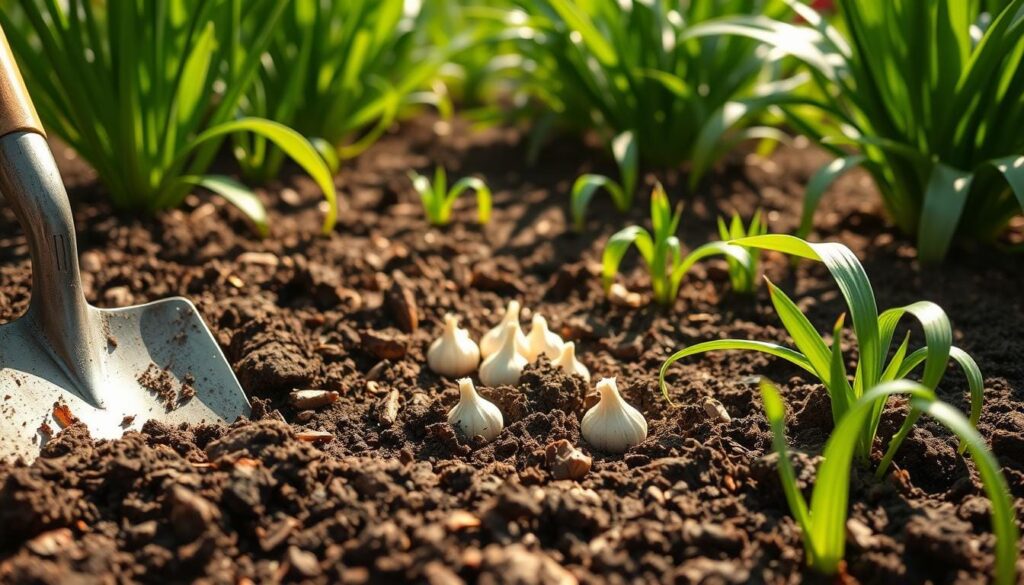
- Soil amendments: Add compost or aged manure to increase organic matter.
- pH testing: Use a home kit every year to keep the acidity just right.
- Companion compatibility: Plant garlic with beets or kale, which like similar soils.
Watering Recommendations
Garlic likes consistent moisture but hates wet soil. Water deeply once a week, more in dry times. When growing with companions:
“Mulch around plants to keep moisture in and weeds out.”
Plants like basil or chives, which are ideal garlic companions, might need the same water. Don’t overwater to avoid bulb rot. Check soil moisture 1–2 inches deep before watering.
Matching garlic’s needs with its companions ensures they both grow well. Good soil and water are key for a healthy garden.
Companion Planting Techniques
Effective garlic companion planting tips depend on smart placement. Intercropping and layer planting help plants grow better and fight less. Try these methods for a lively garden.
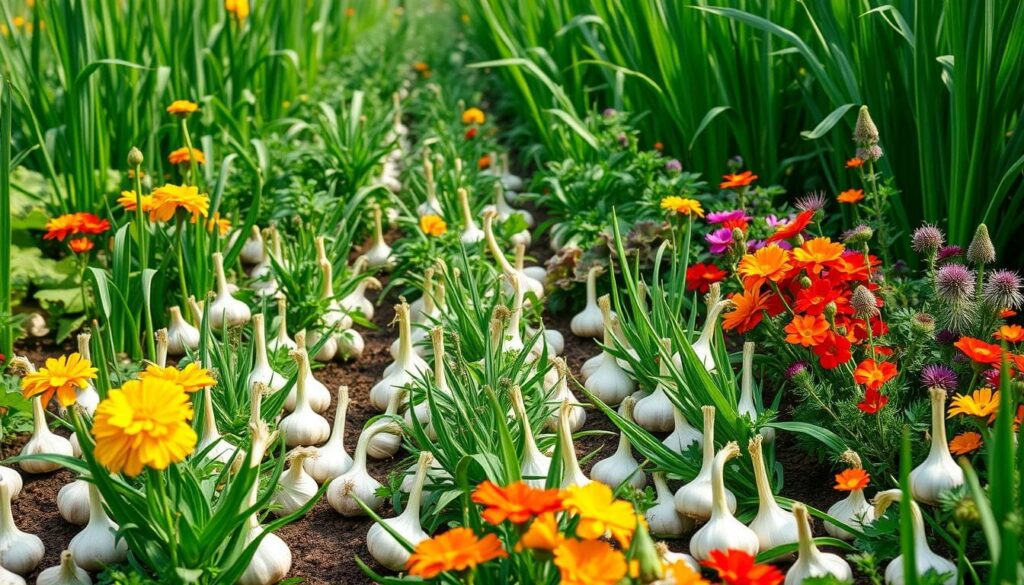
Intercropping Strategies
There are three ways to mix garlic with other plants:
| Strategy | How It Works | Example |
|---|---|---|
| Row Intercropping | Alternate rows of garlic with companion plants | Garlic rows paired with carrots or radishes |
| Strip Intercropping | Plant garlic in blocks separated by strips of another crop | Garlic strips with spinach or chard |
| Mixed Intercropping | Scatter plants randomly for natural pest disruption | Garlic and marigolds interminging to deter insects |
Make sure plants are the right height and grow at the same pace. This prevents shading and overcrowding.
Layer Planting Concepts
Using vertical layers can make the most of space. Fast-growing plants fill in gaps before garlic is ready. Lettuce and other greens do well in the shade of tall garlic.
- Understory layer: Leafy greens (kale, arugula) under garlic
- Middle layer: Climbers like peas trained on supports near garlic beds
- Ground layer: Radishes or onions in between garlic bulbs
Layer planting with garlic boosts harvests without making the garden too complicated.
Seasonal Considerations for Garlic Companion Plants
Timing is key for garlic companion planting. Planting at the right time helps both plants grow well. A garlic companion planting chart makes planning easier, considering your area’s climate and plant needs.
“Seasonal alignment ensures companion plants and garlic thrive together,” notes the USDA Agricultural Handbook.
Ideal Seasons for Planting
Here are some tips for planting at the best times:
- Fall: Plant garlic and frost-hardy friends like kale or onions.
- Spring: Add the best companion plants for garlic such as basil or spinach. Make sure to leave enough space as garlic grows.
- Summer: Choose plants like marigolds or chives that don’t need much water. Switch out plants to match garlic’s growth.
Timing for Harvesting
Harvesting needs careful planning to protect garlic:
- Take out fast-growing crops (like radishes) before garlic gets too big to avoid competition.
- Use raised beds for tall plants like tomatoes. This way, they won’t shade garlic.
- After harvesting, plant cover crops like clover to enrich the soil.
Adjust your plans based on your USDA hardiness zone. In zones 5-7, plant early in spring. Zones 8-10 can plant later for a longer harvest season.
Pest Management with Companion Plants
Effective pest management starts with smart plant pairings. Garlic companion plants can disrupt pests’ feeding patterns and protect crops without chemicals. Certain species release natural repellents or confuse insects, reducing infestations organically.
Natural Pest Deterrents
Specific garlic garden companions deter common pests:
- Marigolds: Release thiopene, a compound that repels nematodes and aphids.
- Chives: Their scent masks garlic’s odor, confusing onion flies and thrips.
- Nasturtiums: Lure aphids away from garlic, acting as sacrificial traps.
Attracting Beneficial Insects
Flowering companions attract predators that control pests. Sweet alyssum blooms draw predatory wasps, while cosmos and yarrow provide nectar for ladybugs and lacewings. These insects prey on aphids, mites, and larvae, creating a self-sustaining pest balance. Planting these flowers amid garlic beds strengthens this ecosystem synergy.
Enhancing Biodiversity with Companion Planting
Companion planting with garlic does more than just increase harvests. It creates thriving ecosystems. By mixing garlic with other plants, gardeners make spaces that support wildlife and improve local areas. This method follows sustainable gardening, making small areas biodiversity hotspots.
Supporting Local Ecosystems
“Diverse plantings mirror natural ecosystems, fostering habitats where pollinators and beneficial insects thrive.”
Garlic and flowers like marigolds or herbs like thyme offer food for bees and ladybugs. This helps reduce the need for harmful chemicals and boosts pollination. Guides like Chiku’s Garden’s guide show how to attract pollinators with companion planting. Diverse plants also keep invasive species away, keeping the ecosystem balanced.
Promoting Soil Health
Varied root systems in garlic companion planting setups improve soil structure. Here’s how it works:
- Shallow-rooted plants like lettuce get nutrients from the topsoil, while garlic’s deep roots reach deeper layers
- Legumes fix nitrogen, making the soil better for future crops
- Mycorrhizal fungi networks expand, helping plants share nutrients
These interactions help prevent erosion and build organic matter. Healthy soil microbes grow in mixed plant communities, naturally fighting diseases. Following a garlic companion planting guide ensures balanced nutrient use and long-term soil health.
How to Create a Companion Planting Layout
Start by planning the layout for garlic and its companions. Think about spacing and looks. Use the best companion plants for garlic to make your garden both full and beautiful. Follow these steps for a garden that thrives.
Garden Bed Planning
First, measure your garden bed. Pick plants from the garlic companion planting chart that match your sun and bed size. Garlic bulbs should be 6-8 inches apart. Make sure paths are wide enough for you to move around.
For example, a 4×8-foot bed can hold 3 rows of garlic. You can plant herbs like rosemary or thyme between them.
- Step 1: Sketch bed dimensions on paper
- Step 2: Select plants from compatible lists
- Step 3: Mark planting zones with string or stakes
Visual Arrangement Strategies
Blend function with style by mixing plant heights and colors. Tall plants like sunflowers protect garlic from wind. Low-growing herbs add texture. Here’s a sample garlic companion planting chart for different garden types:
| Garden Type | Companion Plants | Spacing | Notes |
|---|---|---|---|
| Raised Bed | Garlic + chives + carrots | 6″ between garlic; 2-3″ for herbs | Use vertical stakes for support |
| In-Ground Plot | Garlic + marigolds + spinach | Rows spaced 12″ apart | Alternate garlic clusters with flower beds |
| Container | Garlic + parsley + strawberries | 1 plant per 12″ pot; cluster containers | Rotate pots for even sunlight |
Adjust spacing based on plant size. Check growth often to avoid overcrowding. A well-planned layout increases both yield and garden beauty.
Harvesting and Post-Planting Care
Getting a good harvest is all about timing and technique with garlic planting companions. Taking good care of the soil after harvest helps it stay ready for future ideal garlic companions.
Harvesting Garlic and Companions Together
Harvest garlic when the bulbs are big but before the companions get too big. Here’s how to do it:
- Check garlic bulb size by gently brushing soil away from necks.
- Cut companion plants like marigolds or basil first to avoid root disturbance.
- Shake soil off garlic roots but leave foliage attached for curing.
Care Tips After Harvest
After you harvest, taking care of the soil is key to keeping your garden healthy. Here’s a simple plan:
| Step | Action | Timing |
|---|---|---|
| Soil Replenishment | Add compost or aged manure post-harvest. | Within 2 weeks after harvest. |
| Cover Cropping | Plant winter rye or clover to prevent erosion. | Early fall in most US climates. |
Cure garlic indoors in a dry, shaded area for 2–4 weeks. Store in mesh bags at 60–70°F (15–21°C). Remember, don’t plant garlic or its relatives in the same spot for 3 years.
Conclusion: Maximizing Your Garlic Yield
Companion planting makes growing garlic a smart and fulfilling task. By picking the best garlic garden companions and using top growing methods, gardeners can boost their harvests. This approach also helps create a balanced garden where garlic grows well with other plants.
Final Thoughts on Companion Planting
Choosing the right garlic companion plants helps control pests and improves soil. Plants like basil and marigold keep pests away and make garlic taste better. It’s also important to space plants correctly and at the right time to make your garden productive.
Encouragement to Start Your Garden
Start with small areas and try out different pairings like garlic and carrots or onions and spinach. Watch how plants interact and change your layout if needed. Guides on harvesting spices can offer more tips for after you’ve picked your garlic. Every step you take towards companion planting brings you closer to a rich, sustainable garden.
